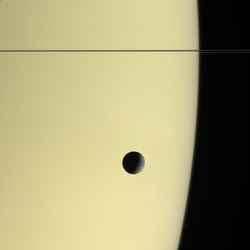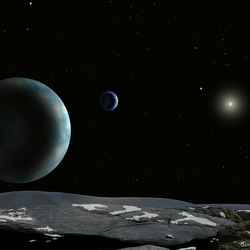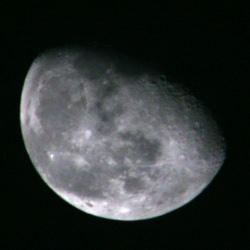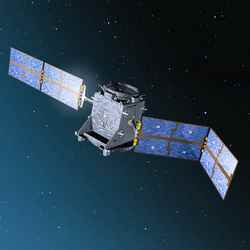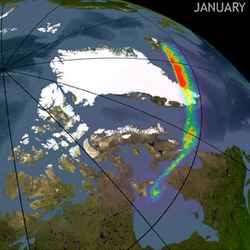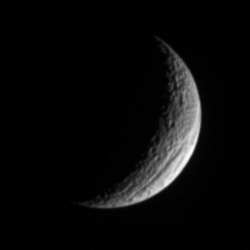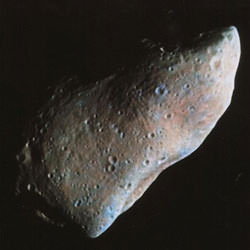
Asteroid 951 Gaspra taken by the Galileo spacecraft. Image credit: NASA/JPL. Click to enlarge.
Listen to the interview: Gravity Tractor Beam (4.8 MB)
Or subscribe to the Podcast: universetoday.com/audio.xml
Fraser Cain: Dealing with asteroids that are going to hit the Earth, now as I understand it, you need to find a crew of top quality oil miners. And you need to put them on the Space Shuttle and send them with a bunch of nuclear bombs to the asteroid to blow it up. Now you’re telling me that maybe this isn’t the best way?
Dr. Stanley G. Love: Well, it depends on what your goal is. If your goal is to make a movie that’s going to make a ton of money, then go wild; that’s exactly the right way to do it. If your goal is to actually prevent an impact with the Earth, though, we’re hoping there might be a simpler method of dealing with this.
Fraser: All right, so what’s the simpler method that you’re suggesting?
Love: Well, the method that we’re suggesting is to send a relatively large and heavy spacecraft – not so large and heavy that we can’t imagine it – to the asteroid, and instead of trying to blow up the asteroid, or land on it and push the thing aside (both of those ideas have been suggested, but they have some difficulties), we’re suggesting you just park the spacecraft next to it and let it hover there. And if you let it hover there for something like a year, very very gradually, the tiny gravitational pull between the asteroid and the spacecraft is going to pull the asteroid over in the direction of the spacecraft. The spacecraft is hovering in a constant distance from the asteroid, and what this means is that it’s very gradually pulling the asteroid off course using gravity as sort of a tow line. And if you can get enough warning on your asteroid – if you know it’s coming 20 years or so before it’s going to hit – then you can get the spacecraft out there and have it pull for about a year, you can pull it enough so that instead of hitting the Earth, it will miss the Earth.
Fraser: Now all the media, and all of those disaster movies revolve around some astronomer spotting a dangerous asteroid three months before it’s going to hit. It sounds like your solution is more in the 20 year range. Do you think that’s the more realistic scenario now these days?
Love: It’s hard to know. We haven’t really discovered all of the asteroids that could potentially hit the Earth yet. We’ve got a lot of people very busily working on that problem; there are searches going on every night. I think a lot of them are automated, and not some lonely guy on a mountaintop with his eye to the lens of a telescope there. And it is possible that tomorrow we could realize that there’s something coming that could hit us that we didn’t know about and it could be three months away from impacting the Earth. That would be certainly unfortunate. But in the future we are likely to know all these things; know all their orbits, and we can predict a hit long before it’s going to hit us. And that’s the sort of scenario that our solution will be able to deal with.
Fraser: And so what size of asteroids would you be able to deal with?
Love: A couple hundred metres in size. So the size of a football stadium or convention center.
Fraser: And what would the spacecraft itself look like? What kind of components would it have on it?
Love: When we came up with the idea for our little paper, we pulled a spacecraft design essentially off the shelf. It’s NASA’s Prometheus project, where they were going to send a large nuclear powered spacecraft to orbit Jupiter’s moon Europa, and do a lot of interesting science there. It’s a 20-ton spacecraft with electric thrusters, that is it uses electric power to heat a gas to extremely high temperatures and squirt it out the back. You get marvelous fuel economy; a lot of ability to move a spacecraft with a small amount of fuel, but the thrust is really low. You can only get a newton, or so (a fifth of a pound) of force. So you have a large electric propulsion, nuclear powered spacecraft – this is probably going to be a long skinny thing, because you’ll need a lot of radiators to reject the waste heat from the nuclear reactor. It’s going to have a set of thrusters, a fuel tank, and some guidance and navigation components. Depending on how you set this spacecraft up, we decided that if you put the reactor, which is heavy, and the fuel tank, which is heavy, down close to the asteroid – hanging from the thrusters – then you get more mass close to the asteroid, and that increases your gravitational pull as gravitational pull decreases rapidly as you increase the distance between the two masses. And it also helps stabilize your spacecraft and just helps you all around if you put your heavy components hanging down by the asteroid with the thrusters up at the top.
Fraser: Oh, I see, it would almost be if you had a ball at the end of a rope, hanging down with the heavy part – the reactor and all the fuel – hanging as close to the asteroid as you can, while all the thrusters are further up the rope pulling it away.
Love: That’s exactly right. Of course you need to tip your thrusters out away so the plume of hot gas coming out of them doesn’t hit the asteroid. It does no good trying to pull an asteroid closer to you with gravity and at the same time that you are pushing at it with your thruster plumes. So you need those outward so the plumes miss the asteroid and that will help improve your towing force.
Fraser: Now do you have any targets that you think might be a good victim of this kind of movement strategy?
Love: We were sort of developing the idea as a generic idea, and fly to anything. However, there’s Asteroid 99942 Apophis which is supposed to make a close pass of the Earth I think in 2029. And if that asteroid happens to pass through exactly the right point in space as it goes past the Earth, it has a chance to come back in 7-8 years and hit us, which would be bad. And that asteroid is an excellent target for this kind of a mission. If we can get to it before that first Earth flyby, that would line it up for impact the second time around. And the reason for that is that these flybys warp the path of the asteroid so that a tiny tiny change in the flight direction before the flyby gives a huge change in the flight direction after the flyby. So it’s like a bank shot in pool. A little tiny mistake on the first part, after the bounce, the mistake gets multiplied. So you could use a gravitational tractor that wasn’t nuclear powered and didn’t weight 20 tons. You could use a 1-ton, chemical-propelled gravity tractor to pull this asteroid just slightly off course before that Earth flyby so the asteroid is going no where near us.
Fraser: I see, if you have an asteroid that coming towards us 20 years out, you could move your big ion engine-powered tractor. How long would you need to have it spend next to the asteroid?
Love: About a year.
Fraser: But if it’s just about to do the flyby, you could give it a very small change and it would still kick it out of the bad orbit and into a good orbit.
Love: Right, you’re going to use that flyby of the Earth to multiply the tiny effect you put on the asteroid with your spacecraft before the flyby. And then after the flyby, the effect is much greater.
Fraser: So what’s the stage of your proposal now? What’s the future for it right now?
Love: Well it hard to know. Right now we’ve made a proposal, we’ve gotten the idea out there, and people are talking about it. My co-author, Ed Lu and I have written many scientific papers for publication, and none of them have received even a tenth as much attention as this one. So the idea’s out there, and we’ll see what happens. I think the debate will become much more pointed if we actually do discover an asteroid that’s on a collision path with the Earth. Then we’ll really need to get together and decide what we’re going to do about it.
Fraser: Well that’s my concern with the whole process of protecting the Earth from asteroids. There’s a lot of uncertainty in predicting when and where an asteroid is going to hit. The better you can mark the orbit, the better you can know if it’s going to be a risk. In many cases, if you’ve got these ones that are 30 years out, decision makers and lawmakers might say: well, let’s wait until we know better. And yet, the more you know better, the less chance you have of changing its orbit.
Love: Yes, that’s always true, and human nature plays into this a lot. Nobody’s every suffered an asteroid strike, so it’s hard to compare it to things that we have suffered, like tsunamis and hurricanes to take a couple of recent examples. The things that we know about and experience in a person’s lifetime are always easier to visualize and understand. And to get people to pay attention to something that seems kind of esoteric and science fictiony; is this real, or are people just making it up? I don’t know a good solution to that, but the fact that people are talking about the idea and thinking about it – and not just in the elevated circles of academia – all over the world, I think is a good sign. At least we’re thinking about the problem and how to solve it.
